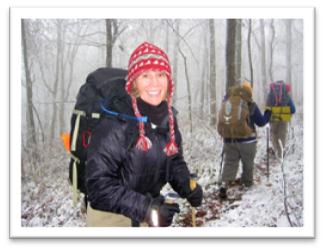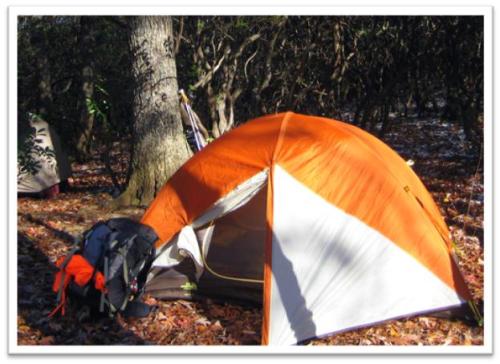
This is a guest post from the Delaware Valley Trail Dames new blog! Link to them here so you can follow their adventures!!
After 2 years enjoying fabulous day hikes, our DelVal Dames have decided to take our hiking to the next level. We’re planning for a backpacking trip later this year. We have a small but enthusiastic group of ladies who want to give this a try. They have little to no experience, but that’s not stopping anyone. I’m so proud of them! And I’m amazed that they have fath in me to teach them how to do this.
Our little core of committed hikers assembled recently to hear me talk about backpacking. I had to come clean to them, though. I told them that I have an ulterior motive. I’m building a cult. Yes, that’s right. I love to hike for days at a time. I really do. But I’m no longer the foolish 18-year-old who heads out alone. Now, I’m nearly 50, wiser, and more mature. For me, the best part of hiking is sharing the experience with friends. So, these clinics are just part of my campaign to get people to go backpacking with me.
Consider yourselves warned. But also be warned, that we will have fun. Above all, though, I want us to be safe which means, just like all good scouts, we must be prepared. What follows are our first preparations for what I hope will be a wonderful backpacking adventure in the near future.
______
Gear! Gear! Gear!
Backpacking sure is a lot of fun. It seems to be quite simple fun, too. We have romantic visions of sleeping under the stars on a soft bed of pine needles, watching shooting stars darting overhead, listening to loons calling across still lakes. It’s true that sometimes those moments of zen can be found in the wilderness. But, it’s not necessarily as simple as that. Just as likely, you may find yourself huddled at the bottom of a tree, soaked to the skin by a penetrating rain, cold and shivering as temperatures drop. And the loons? You couldn’t hear them over the thunder anyway! So what is the difference between these two scenarios? Simple. Preparation. And Preparation means Gear to our first-time Trail Dames backpackers.
Gear includes all that stuff that makes your life comfortable and safe in the outdoors. In some cases, your gear may be what keeps you alive. What do you need? A pack, tent, sleeping bag, compass, map, flashlight, a really cool multi-tool, the ice axe the guy at the outfitter said you’d need at elevation (has he ever been to the Poconos in winter?). And what about the solar-powered microwave, wicking wrist warmers, heart rate monitor, and climbing ropes? Whoa! How did this get so out of control? I can’t carry all that stuff, and neither can you. We could take some really cute sherpas along, or perhaps rent some pack mules, but that’s probably too much work, too.
Think about how our lives become simplified by living on the trail. We have three tasks every day that we are on the trail. We walk, we eat, we sleep. That’s it. Life is simple. So, as we consider gear, we need to think about what we need to walk, eat and sleep. This clinic was a basic orientation. So, we didn’t go into painful detail about each piece of gear we’ll need. But we did cover the walk, eat, sleep tasks. So, let’s start there.
Walking: This is the meat and potatoes of your hiking experience. Well, you could also have meat and potatoes for dinner, but let’s save that for another clinic. When walking, we need to think most about our feet and our backs. We need good fitting shoes or boots, good socks dedicated to hiking (not cotton athletic socks), and we need a VERY well fitted backpack. An ill-fitting pack, one that is not adjusted and strapped on properly, will suck the energy out of you and recruit your spine to the dark side so that it becomes a construct of pain rather than support. We’ll save the footwear discussion for another clinic and go straight to the backpack.
FITTING A BACKPACK: Backpacks come in sizes. Features such as capacity, access points, water bottle holders, etc., are great, but if the size does not match your torso length, you will struggle. And torso length has nothing to do with your dress size or height. Short people may have long torsos and tall people can have short torsos. The only way to know your torso length is to measure your torso length. Armed with this measurement, you can make a good pack choice.
It helps to have a second person assist you when measuring your torso. Use a tape measure and stand up straight, feet together and shoulders back. Now, drop your chin to your chest. At the base of your neck on your back you should easily feel a bump. This is your C7 vertebra. This is the start of the measurement. Now, find your iliac crest by putting your hands on your hips, thumbs pointing towards each other across your back. The imaginary line connecting your thumbs marks your iliac crest. The length measured from the C7 vertebra to the iliac crest is your torso length. Backpack manufacturers have different guidelines, but generally, 15″ to 17″ is a small pack, 17″ to 19″ is a medium, and 19″ to 21″ is a large pack. Some manufacturers also make XS and XL packs, and many are adjustable for an inch or two. If you get this measurement right, you will be well on your way to a comfortable carry on the trail.
When considering a pack, volume is also important. For our Trail Dames purposes, we will be doing mostly weekend trips. Buying a very expensive lightweight or ultralightweight pack may not be so important for short trips. And, the high end fabrics that go into making such packs makes them more expensive. Considering that we will be sharing some gear and carrying less food on weekend trips, a less expensive, heavier, more basic pack should be just fine for our basic beginning trips. Go to an outfitter or sporting good store and try on packs that suit your torso length. Get some weight into the packs when you try them. Outfitters usually have sandbags available. But if nothing is available, put some merchandise in the pack and weight it down with 20 or so pounds. An outfitter will be pleased to show you how to adjust the straps, but if you are on your own, remember to fasten your straps from the bottom up.
Here are the steps to putting on a backpack properly:
1. Loosen all straps. Slip your arms through the straps and lean forward, bending from the waist. Center the pack and balance the weight. Now tighten the hip straps. Many guides say that the hip belt should fall just at your belly button, but I’ve found that most women like it slightly lower than this. Each person is different, though. Start out by tightening the hip belt at the level where the waist of your favorite jeans falls.
2. Now stand up straight. Pull down on the shoulder strap adjustments until they are snug.
3. Reach up above the shoulders and pull the load lifter straps forward. This should form an approximately 45 degree angle from the pack to the top of your shoulders.
4. Adjust the sternum strap across your chest.
These are the basic steps. Depending on the pack, there may be other adjustment options. And, no adjustment is permanent. No one ever puts on a pack after breakfast and doesn’t make adjustments several times throughout the day. Strap placement and features, and your particular body shape will impact the comfort level of your backpack. The only way to know if the pack is right for you is to try it on.
Now that you have an idea of what to look for when purchasing a pack, I’m sure you are wondering where to buy a pack. REI and Eastern Mountain Sports are major outfitters in the Delaware Valley. You can also find backpacks at places like Dick’s Sporting Goods and Cabelas, too. Salespeople may or may not have expertise to help you at any of these stores. I think REI is usually pretty good when it comes to knowledgeable staff, but there is no substitute for your own knowledge. If you go in there with a basic understanding, you will be able to make a better purchase.
You can also check for deals on eBay, but of course, you will not be able to try on a pack before purchasing. If you go this route, be very careful, do your research, and know the seller’s return policy. This is not my recommended route for obtaining a first-time backpack, but I know that it’s possible (if not necessarily probable) to get an amazing deal on a wonderful pack through an online auction.
I hope you found this summary of our first clinic helpful. If you missed our first meeting, no problem! Come on out and join us at another clinic soon. Members of the Delaware Valley Trail Dames can visit our Meetup site to see a full schedule of events. I look forward to seeing you on the trail!

 First, a corner, expanding quickly to the corner chair and creeping over the end of our bedroom. The spreadsheet has been printed with the highlighter nearby. A nearobsessive affair with the weather channel begins. Backpack has been emptied and slowly expandsas things are added and checked off the list.
First, a corner, expanding quickly to the corner chair and creeping over the end of our bedroom. The spreadsheet has been printed with the highlighter nearby. A nearobsessive affair with the weather channel begins. Backpack has been emptied and slowly expandsas things are added and checked off the list. 



